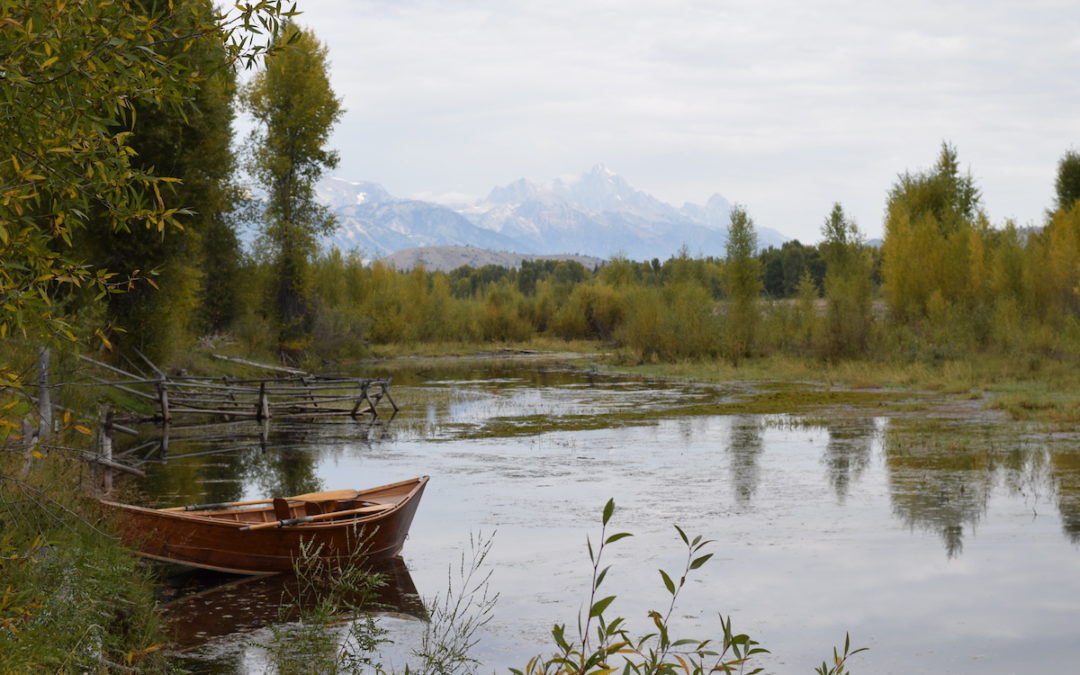
by jhwildlife | May 16, 2018 | Blog, Nature Mapping Jackson Hole

Three mule deer does and a fawn spotted on the Sept. 10, 2017 float trip. Photo credit: Forest Dramis.
A quick step into the dory and a careful shifting of weight with binoculars raised and off we go, five lucky Nature Mappers floating the Snake River on a sparkling Sunday morning. We glide swiftly and smoothly under the Wilson Bridge (with the chittering of swallows and clamor of traffic overhead) and emerge, calling out: “Two, no three Ravens!” “16 Tree Swallows, I think? They move fast.” “Look, a Great Blue Heron!” “No, Osprey!” “Both!”
As we flow downstream, we scan the shorelines, water and sky, and settle into intervals of excitement and tranquility. A designated Nature Mapper jots down the tally for common species and takes GPS points for unusual sightings. A morning’s count can include eight Bald Eagles, a moose, numerous Spotted Sandpipers, Common Mergansers, Yellow Warblers, nesting Bank Swallows and a flotilla of American White Pelicans. Or perhaps we spy a marmot family basking on a rock, or a beaver up a backwater.
For seven years, Nature Mappers have been gathering data on wildlife thanks to A.J. DeRosa, owner of Jackson Hole Vintage Adventures. A.J. donates his handcrafted wooden dory and an expert boatman every Sunday morning from May to October. With this opportunity for consistent data collection, Nature Mappers have been able to record trends and shifts in species’ numbers and locations over the summer months (May-October), year to year. We are beginning to discern patterns in species’ migrations, nesting locations, and possibly, with time, impacts of flooding, dike vegetation management and river use.
These results are possible thanks to over four-dozen trained nature mappers and friends participating each year. Ace volunteer Tim Griffith schedules the teams and often adds his expertise on the floats. Since Tim started coordinating the trips with A.J., many species’ sightings have increased significantly. Tim has a fine ear and eye for the birds! Please read Tim’s 2017 Nature Mapping Jackson Hole Snake River Float Trip Annual Report here. It includes a species list and numbers; the special conditions of 2017 during the spring flood and its effect; and the season’s variation in eagle numbers. Be sure to contact Tim if you wish to volunteer on a Snake River Float Trip this summer!
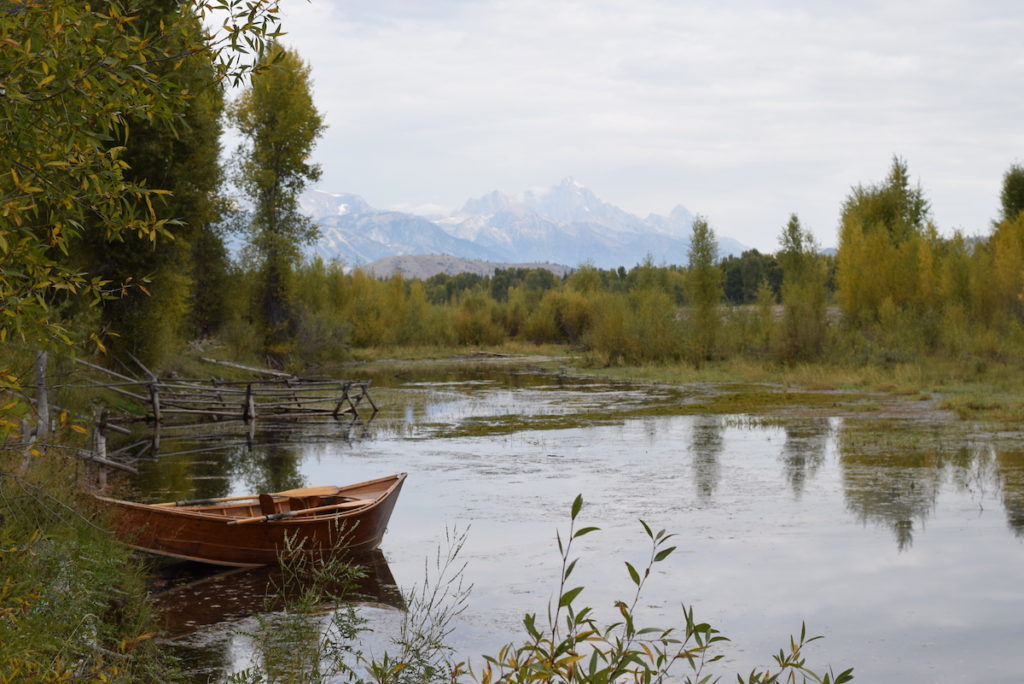
An idyllic setting, Jackson Hole Vintage Adventures Tipi Camp is a wildlife rich habitat Photo credit: Forest Dramis
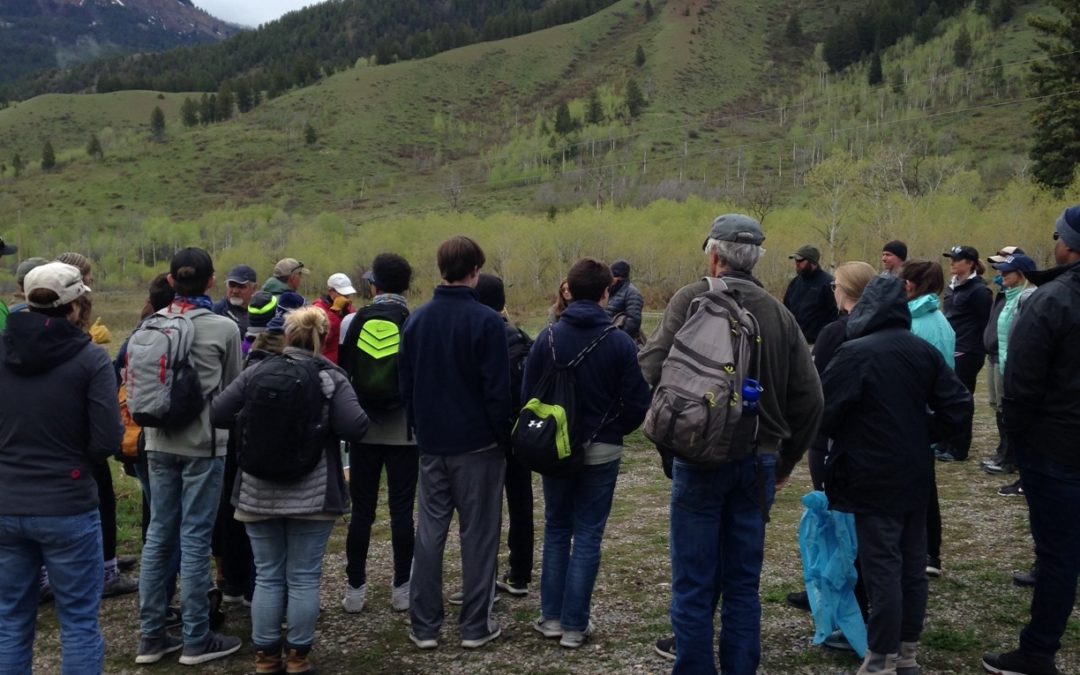
by jhwildlife | May 14, 2018 | Blog, Wildlife Friendlier Landscapes
by Jon Mobeck, Executive Director
A steady rain saturated the ground as I looked out the window. It was 5:30 a.m. on the day of a fence pull – Saturday, May 12. It’s hard not to feel that a bit more sleep would be a better choice than pulling down barbed wire fences, but that fleeting thought is dismissed as I think about the others who are doing – and maybe thinking – the same thing. I’ve done this work in the rain before, but nowhere near as many times as those key “Fence Team” volunteers who I would join later that morning. And then I have the thought of all the people who have done this over the past two decades, in all sorts of weather conditions, in any terrain. There was never really a doubt that we would pull down fence that day.
On this day, we were scheduled to benefit from a large volunteer crew generously offered by EcoTour Adventures. EcoTour was hosting a group of 16 students from a school in Louisiana along with an equal number of parents. While visiting (vacationing) here, the Louisianans would see the typically amazing sites of Jackson Hole, experience exhilarating adventures, and learn about the area’s wildlife and natural gifts from EcoTour’s exceptional guides. Because of EcoTour’s commitment to the area’s wildlife, they encourage their guests to participate in activities that help preserve what makes this place special.

On this day, though, with rain coming down and more rain forecast throughout the day, I had assumed that the group would cancel, and I wouldn’t have blamed them for a second. After all, they were on vacation. Pulling down barbed wire fences in the rain is not high on the “to-do” list for most of the vacationing public.
So at 7:22 a.m., when EcoTours CEO Taylor Phillips texted: “OK we are all in for the fence pull. Expected arrival 9:15. Yahoo!” I was surprised. I knew I would be meeting our indefatigable Fence Team volunteer leaders Gretchen, Steve and Randy since we had all decided that we were going no matter the weather, but now the prospect of our small team working through the rain turned into the excitement of a huge group (41) of us doing so together.
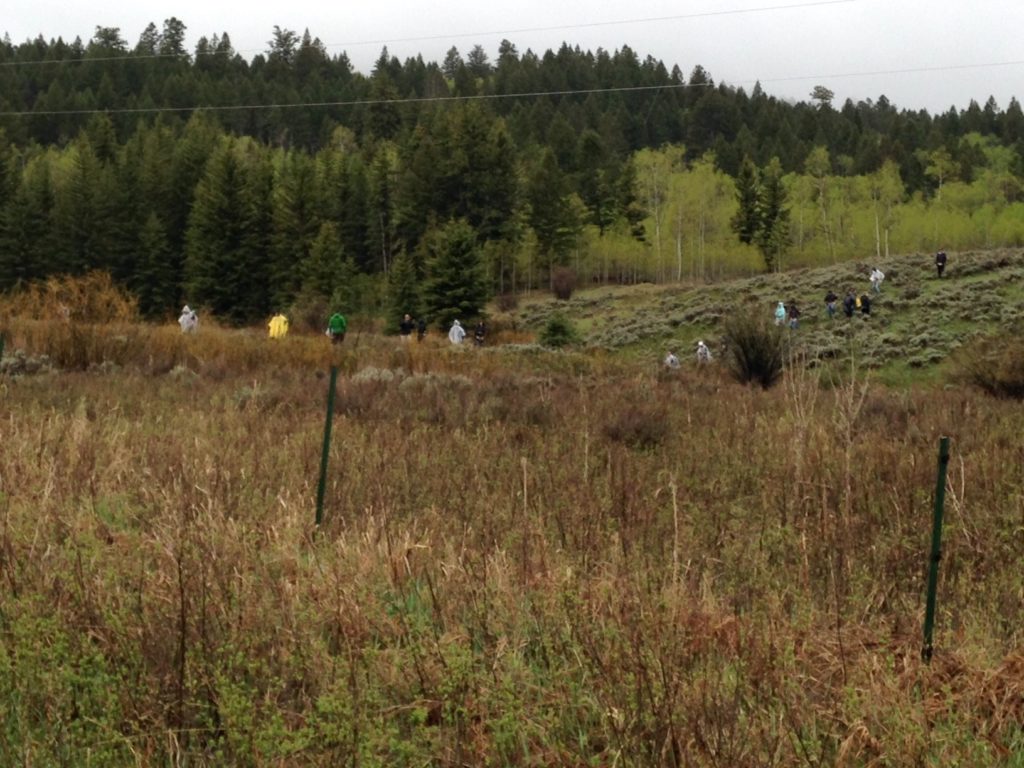
As it turned out, the rain was relatively light throughout most of the project, and I was amazed by the resilience of the Louisianans. I suppose they are accustomed to rain, but as one of the parents – James – said, “We don’t get to do anything like this in Louisiana.” The Louisianans worked for 3 hours with us, and it sure seemed like they were having a good time. That knowledge filled me with joy. Here all of us were, in the rain, removing barbed wire fences to make things easier for wildlife. And it was fun! And it reminded me of how great it is to share such an experience with new people, from a different place. We’re all so similar, and we all can do so much together!
Of course, we do this for the wildlife. On this occasion, we worked in an area at the northernmost end of the recently mapped Red Desert-to-Hoback Mule Deer Migration Route. The Wyoming Migration Initiative elucidated this 150-mile route through extensive GPS collaring and subsequent mapping that is now recognized and discussed around the world. Each spring, mule deer that were once thought to be a resident population of the Red Desert region migrate across and through many roads, houses, industrial developments, and about 100 fences before finding summer range in the greater Hoback area. We worked near those summer ranges, where they will spend considerable time, removing obstacles that can separate fawns from does, and just generally make their route more challenging.
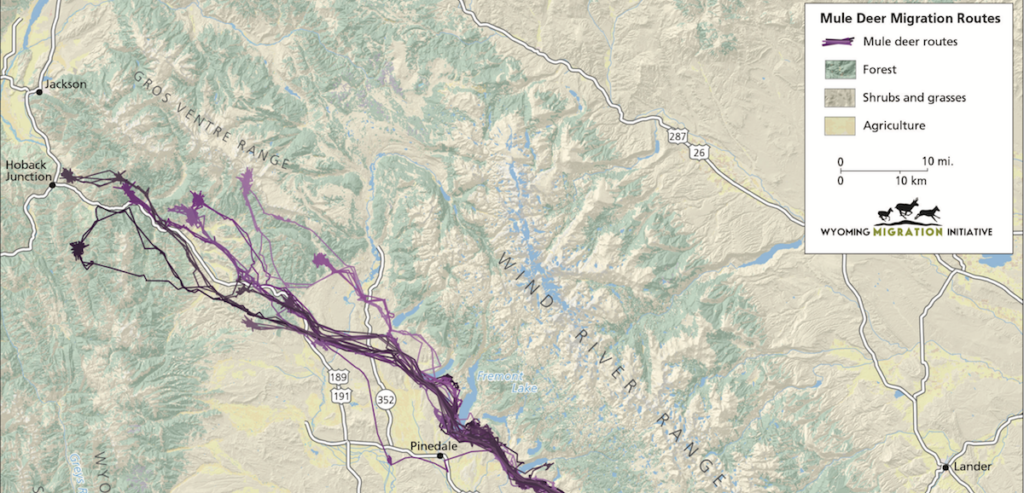
The northern end of the Red Desert to Hoback Mule Deer Migration Route, as identified by Wyoming Migration Initiative, which includes summer range for mule deer.
We were on Bridger-Teton National Forest Land, where we removed about ½ mile of nasty barbed wire fences. It is a privilege to be able to support our agency partners who couldn’t possible deploy enough staff members to remove or maintain every fence in the region. Our volunteer fence pullers pitch in to care for our public lands in partnership with those terrific land managers.
Hundreds of individuals have helped in this way over the past two decades. Some of whom have been on hundreds of fence projects. I’m personally grateful to all of them, and when I pull my boots on to go work on fences, I know that I’m part of something much bigger than me, in so many ways. It is a big, impressive landscape. It is an amazingly long mule deer migration. There are so many people over many years. There is still so much to do.
Thank you to those great young people from Louisiana and their parents, and to EcoTour Adventures. We’re all a part of a great tradition of giving back to the land!
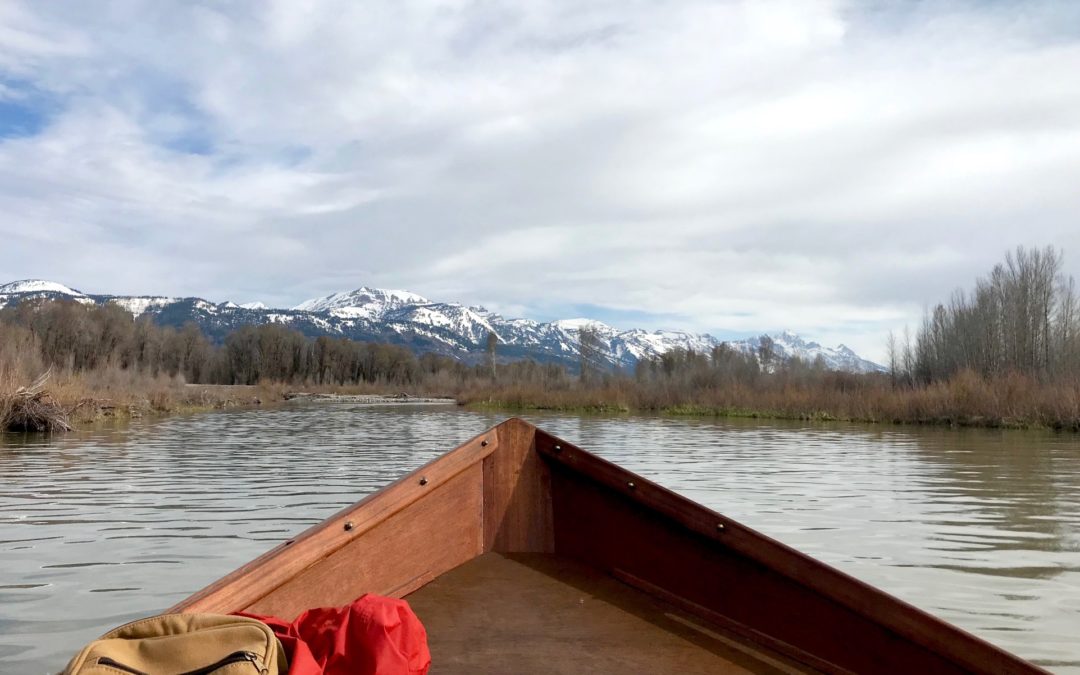
by jhwildlife | May 9, 2018 | Blog, Nature Mapping Jackson Hole

“You can’t be unhappy in the middle of a big, beautiful river.” – Jim Harrison
On Sunday, May 6, I had the privilege of participating in my first Nature Mapping Snake River float trip. And what a trip it was!
Along with fellow “bird nerds” Jon Mobeck and Tim Griffith (trip leader/coordinator) and guide Adam “Dutch” Gottschling, I spent two hours of the morning floating the eight-mile stretch of the Snake River between the Wilson bridge and Jackson Hole Vintage Adventure’s Tipi Camp.
Having recently moved to Jackson from the relatively flat plains and forests of the upper Midwest, I have a long way to go before I look up at the grandeur of the Tetons with anything but complete and utter awe. So, had we merely floated for two hours looking only at the river and surrounding mountains, without seeing any wildlife, I personally would have considered my Sunday morning well spent.
That said, we ended up observing over 40 species of birds, mammals and amphibians along the river and in the area immediately surrounding the Tipi Camp. Not bad for the first week of May! (Indeed, I’ve since learned that this is on the high end compared to historic species counts.)
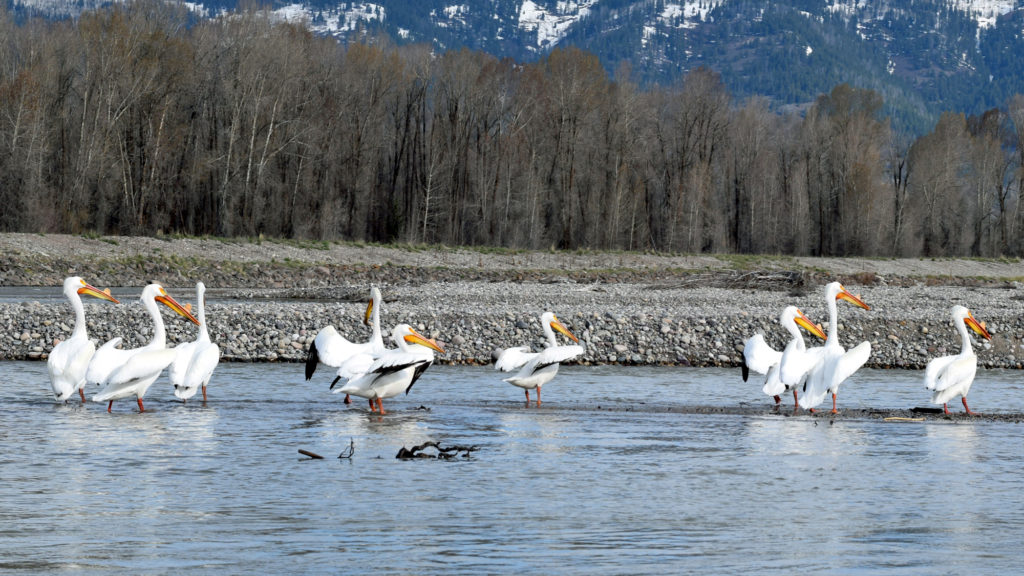
Highlights included 54 American White Pelicans (the largest number ever recorded on one trip), one Swainson’s Hawk, one Merlin, a Greater Yellowlegs and two moose. Though, based on the excitement in the boat, to call the Merlin and Greater Yellowlegs mere highlights is a gross understatement. For good reason too! It turns out only a handful of each species have been spotted by volunteer citizen scientists since the trips began in 2010.
I’d like to say it was beginner’s luck, but I’ve spent enough time appreciating the wild spectacle that is nature to know that to try to claim any credit is silly at best. Besides, who knows what will be seen throughout the rest of this summer? Either way, this trip was an awesome start to what is sure to be an amazing float trip season. Even without such a notable species list, I feel lucky to have been a part of such an experience—to have spent the morning exploring an area of nature that few have the chance to see in a way that even fewer are able to see it.
JHWF partners with AJ DeRosa’s Jackson Hole Vintage Adventures to provide this incredible opportunity to float down the eight-mile stretch of the Snake River between Wilson Bridge and South Park and to collect important data about the various species of mammals, birds and amphibians that use it. Trips take place every Sunday morning from May 6, 2018 through the end of September. Cost is $30 per participant. To learn more, visit the Snake River Float Trip webpage or call the office at 307-739-0968. To sign up for an upcoming trip, contact project coordinator and expert birder Tim Griffith at timgrif396@gmail.com.
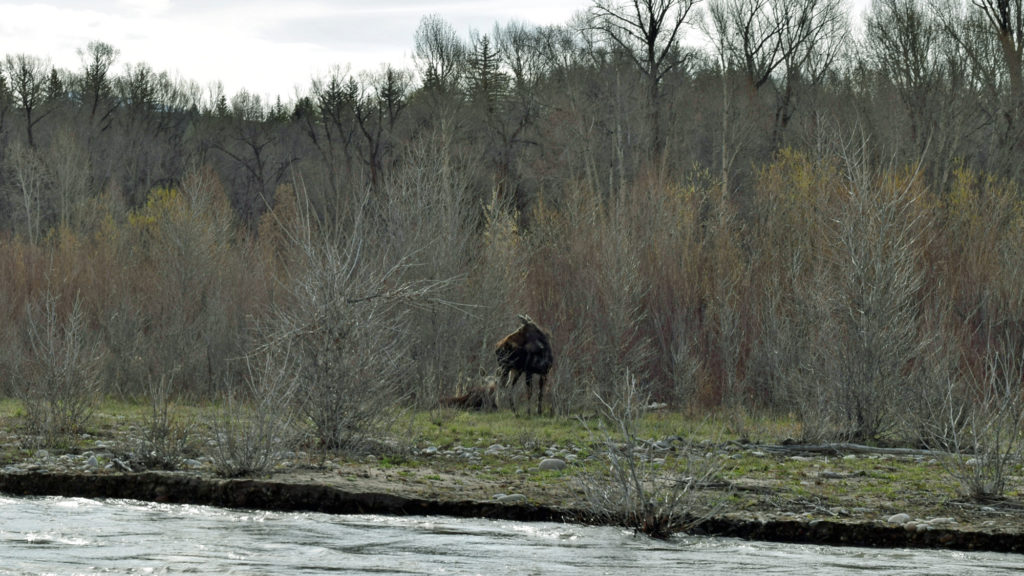
Species Counts Along the Snake River
May 6, 2018 8:00 AM – 10:00 AM
Canada Goose 144
Mallard 56
Barrow’s Goldeneye 1
Common Merganser 24
American White Pelican 54
Great Blue Heron 3
Turkey Vulture 4
Osprey 1
Bald Eagle 6
Swainson’s Hawk 1
Red-tailed Hawk 1
Killdeer 3
Spotted Sandpiper 10
Greater Yellowlegs 1
Belted Kingfisher 4
Northern Flicker 4
Merlin 1
Black-billed Magpie 6
American Crow 14
Common Raven 3
Tree Swallow 50
Bank Swallow 5
Cliff Swallow 2
Black-capped Chickadee 7
Ruby-crowned Kinglet 11
Mountain Bluebird 7
American Robin 31
Yellow Warbler 1
Yellow-rumped Warbler (Audubon’s) 5
White-crowned Sparrow 2
Song Sparrow 47
Red-winged Blackbird 11
Brown-headed Cowbird 2
Brewer’s Blackbird 7
Moose 2
Marmot 2
Species Counts at Jackson Hole Vintage Adventure’s Tipi Camp
May 6, 2018 10:15 AM – 10:45 AM
Canada Goose 3
Mallard 3
Green-winged Teal 2
Common Merganser 2
Ruffed Grouse 1
American White Pelican 4
Osprey 2
Killdeer 1
Spotted Sandpiper 3
Downy Woodpecker 1
Common Raven 1
Tree Swallow 1
Black-capped Chickadee 6
Ruby-crowned Kinglet 5
American Robin 5
Yellow Warbler 1
Yellow-rumped Warbler (Audubon’s) 5
Dark-eyed Junco 1
White-crowned Sparrow 1
Song Sparrow 4
Red-winged Blackbird 1
Brewer’s Blackbird 2
Chipmunk 1
Frogs ? (unable to get an exact count)
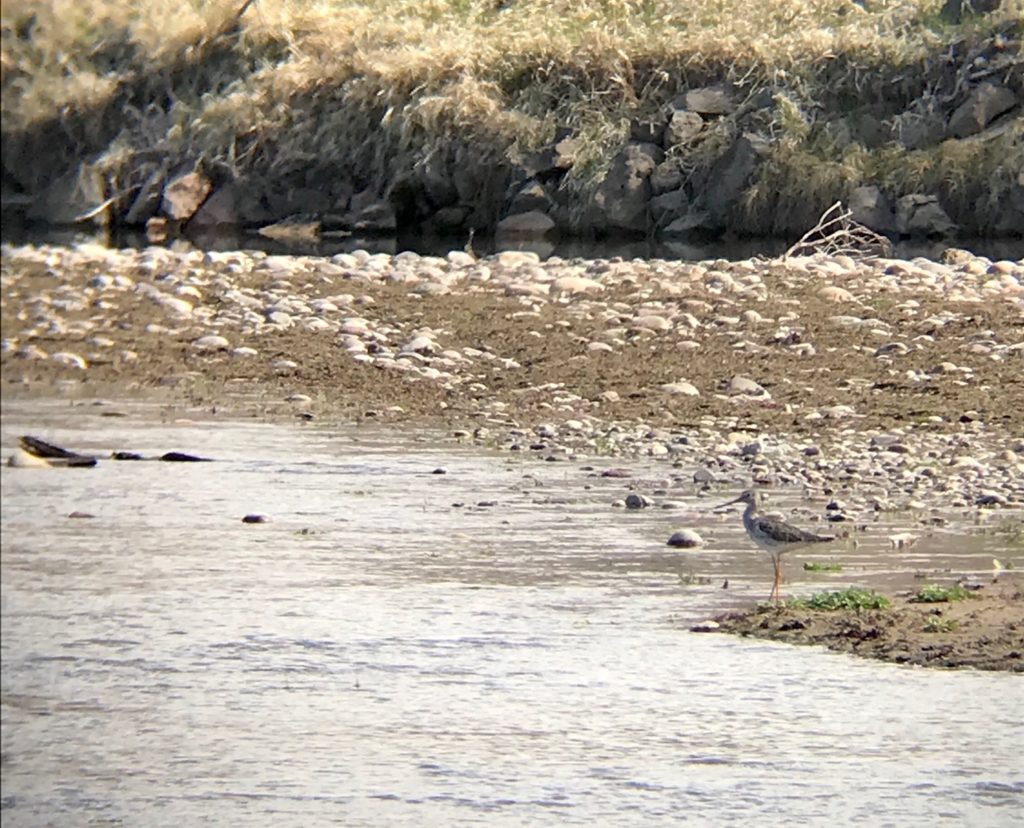
Greater Yellowlegs!!

by jhwildlife | May 4, 2018 | Blog
We are excited to welcome Bruce Pasfield to the Jackson Hole Wildlife Foundation’s (JHWF) Board of Directors executive committee as vice president and Ben Wise as a new board member.
Bruce Pasfield is an attorney who practices environmental law in Wyoming and Washington D.C. He is currently a partner in the law firm of Alston and Bird and has served on the JHWF board since October 2016. Residents of Jackson Hole since 2010, Bruce and his wife Nancy are certified Nature Mappers and frequently volunteer on fence projects. Bruce brings enthusiasm and natural curiosity about wildlife, as well as his legal skills, to his position on the executive committee. Bruce enjoys spending time with his wife and two grown children, mostly in the outdoors birding, cycling, climbing, hiking and skiing.

Bruce Pasfield helps on a fence project last fall on Public Lands Day.
A Worland, Wyo. native, Ben Wise has worked as the Brucellosis-Feedground-Habitat Biologist for the Wyoming Game & Fish Department in the Jackson Region since 2013. Ben is a key volunteer and strategist for the Wildlife Friendlier Fencing program. He also volunteers his time on the Scientific Advisory Committee (SAC) for Nature Mapping Jackson Hole, vetting observations and advising JHWF on scientific goals for the array of projects. In his free time, Ben enjoys traveling, hunting, fishing and exploring all that Wyoming has to offer.

Ben Wise releases a bighorn sheep during a collaborative research project.
The JHWF Board of Directors is comprised of a diverse group of individuals with varied backgrounds including wildlife biology, wildlife management, public relations, law, conservation, planning and development, private business and local government.
The board represents a good cross-section of the community and enables us to have thoughtful debate about current issues and seize opportunities to advance meaningful on-the-ground work. Many board members contribute extensively as volunteers to increase our impact in our core program areas, extending a hands-on legacy that dates back to the origin of the organization in 1993.

by jhwildlife | Apr 30, 2018 | Blog, Nature Mapping Jackson Hole

Cyclists gather at Bradley-Taggart parking lot for leg two of the Mountain Bluebird Classic.
Jackson Hole Cycling’s unique fundraiser on two wheels this past Saturday, April 28, 2018, brought in over $1,200 for Jackson Hole Wildlife Foundation’s (JHWF) Bluebird Nestbox Project.
The “Mountain Bluebird Classic” is an annual spring group ride of the area’s road cyclists. Named for the mountain bluebirds who are busy building nests in cavities during the spring, the cyclists meet at the Home Ranch Visitor Center and ride to the Bradley-Taggart Lake parking lot to meet others who want to ride a shorter 30-mile version of the social ride (from Bradley-Taggart parking lot to Signal Mountain and back).
This year, the National Elk Refuge (NER) was able to open the north pathway early so the cyclists braving the longer 70-mile version of the road ride were able to see many of the nest boxes along the NER’s western border that JHWF installed and have been monitoring since 2003.
Last year, Jackson Hole Cycling’s executive director, Forest Dramis, asked participants to make donations for JHWF’s Nature Mapping Jackson Hole project, which recently added mountain bluebird banding and resighting to its conservation and research efforts. The 2017 ride brought in almost $300 while the 2018 ride raised over $1,200, so far. JH Cycling matched the riders’ donations this year.
Approximately 60 riders took part in this year’s event, which featured “bluebird” skies and unseasonably warm temperatures in the mid-60’s. Two riders even came from out of town for the scenic ride. One cyclist who did the ride last year came back all the way from Minneapolis, Minnesota to tackle the challenging social ride in Grand Teton National Park (GTNP). Another traveled from California to ride with her nephew.
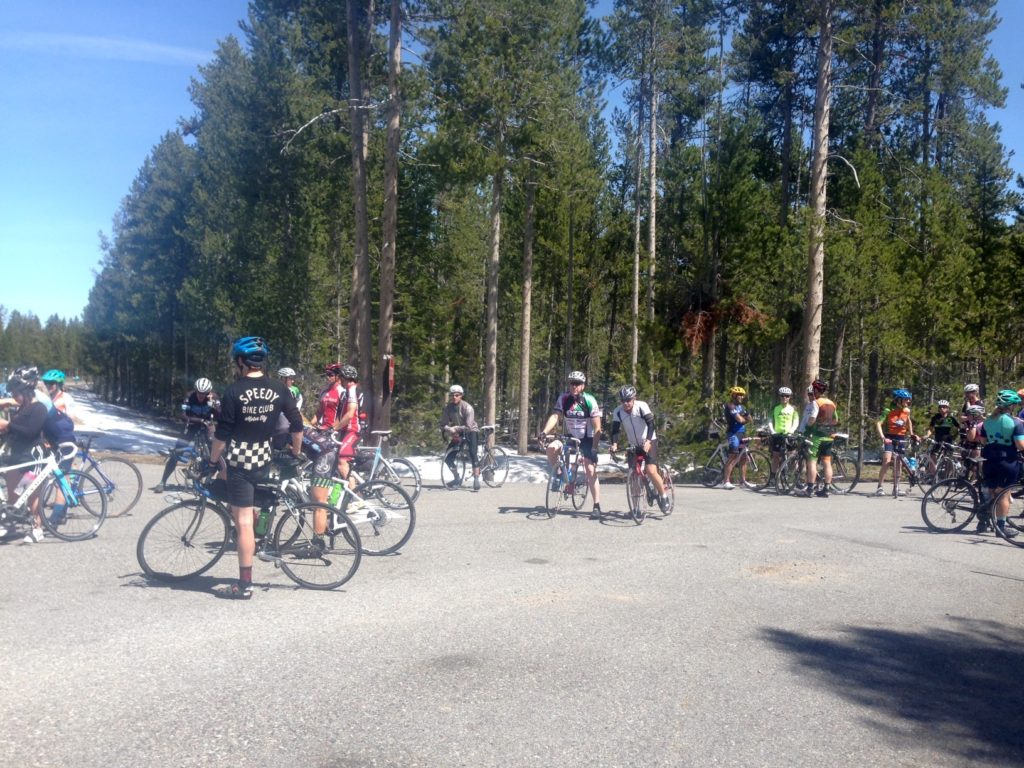
Cyclists regroup at the base of Signal Mountain during the Mountain Bluebird Classic.
The Mountain Bluebird Classic was envisioned eight years ago by avid cyclist and science educator Aaron Nydam who wanted to create an event that captures the spirit of cycling and is inclusive to most all levels.
About Jackson Hole Cycling:
A 501 (c)7 non-profit organization, Jackson Hole Cycling is a group of avid cyclists living in Jackson Hole, Wyo. They provide information and events that help people enjoy the some of the best riding in the country, both road and mountain. (www.jhcycling.org)
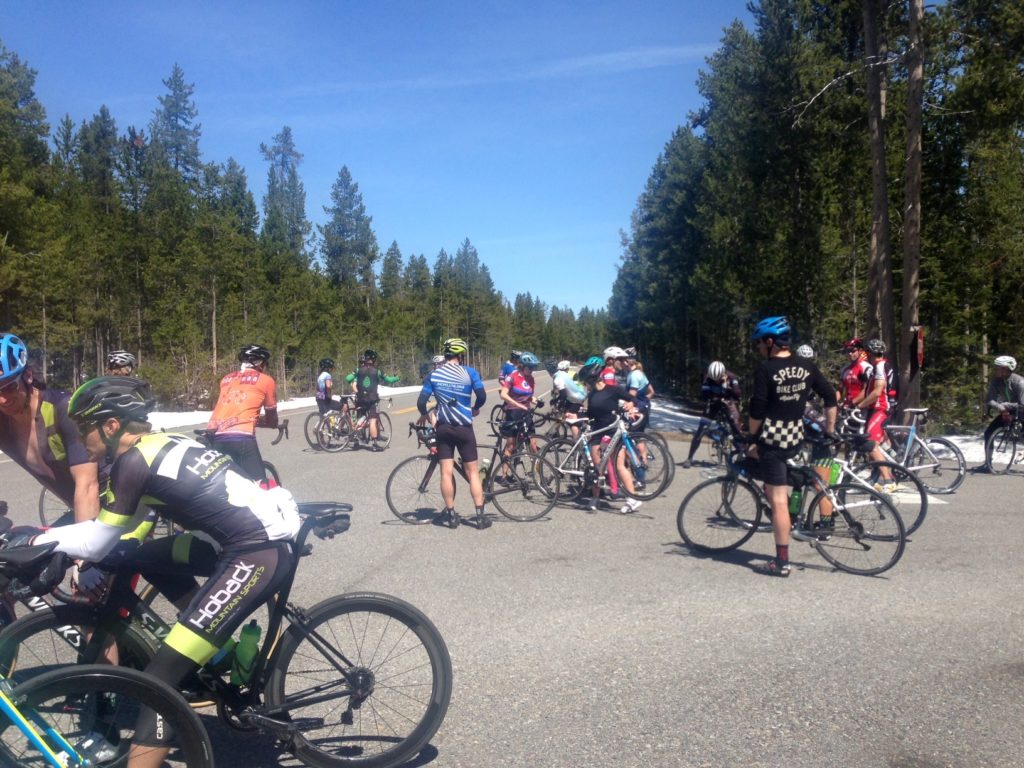
Approximately 60 cyclists participated in the 2018 Mountain Bluebird Classic.



















